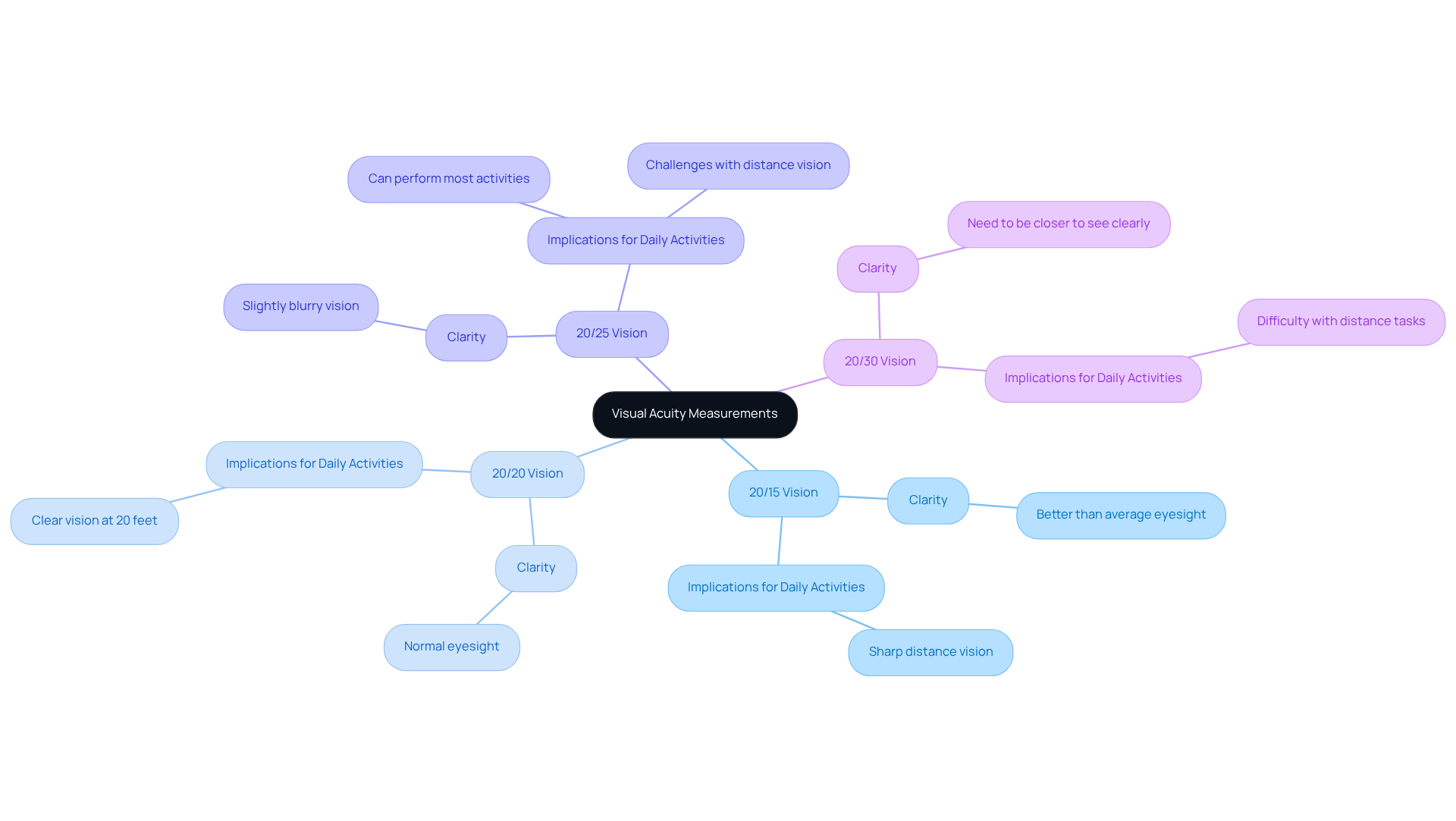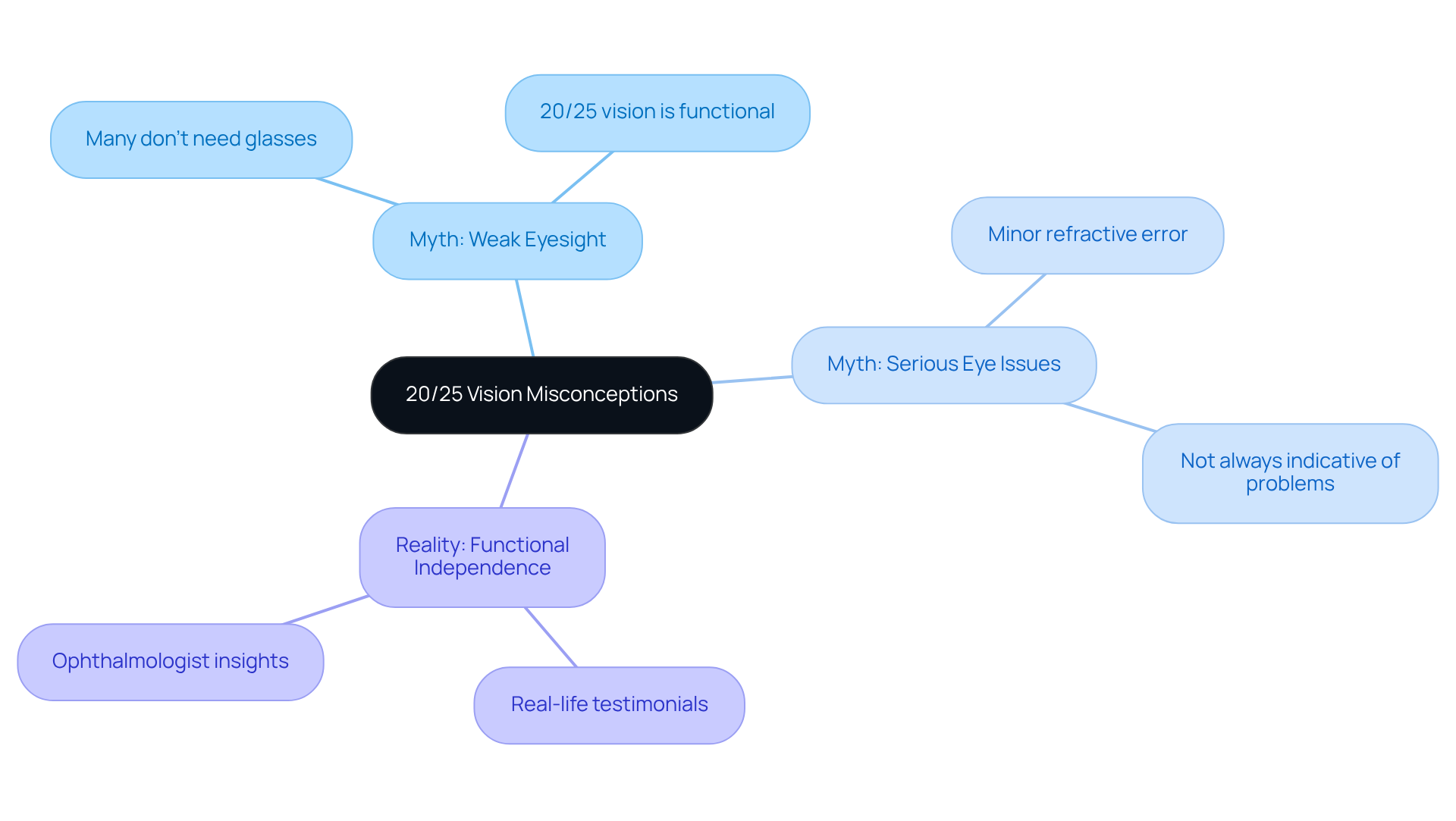Posted by: Northwest Eye in General on June 25, 2025
Overview
Having 20/25 vision means that you can see at 20 feet what someone with standard vision (20/20) can see at 25 feet. This indicates a slight reduction in visual clarity, but it is generally sufficient for most daily activities.
We understand that individuals with 20/25 vision may have minor challenges, such as seeing distant objects clearly. However, it’s important to know that most people in this category do not require corrective lenses. They can effectively manage everyday tasks without significant difficulty, and this can be reassuring.
Remember, you are not alone in this journey, and we are here to help you through any concerns you may have.
Introduction
Understanding visual acuity can be a perplexing journey. We recognize how navigating the nuances of measurements like 20/25 vision can raise questions and concerns. This specific level of sight indicates that a person can see at 20 feet what someone with perfect vision (20/20) can discern at 25 feet.
While many individuals with 20/25 vision can function without difficulty, it’s common to feel some apprehension about this slight deviation from the norm. What does it truly mean to have 20/25 vision, and how does it impact everyday experiences? We are here to help you through this process.
Define 20/25 Vision: What It Means
Having is a specific measurement of visual sharpness. It means that a person can see at 20 feet what someone with standard sight (20/20) can see at 25 feet. While this slight reduction in clarity might seem concerning, it’s important to know that many individuals with 20/25 vision can still without any issues.
The first number, 20, indicates the distance at which the test is conducted, while the second number, 25, shows the distance at which a person with typical eyesight can clearly see the same detail. This means that 20/25 eyesight is somewhat below the benchmark of typical sight, but it is not classified as poor vision. In fact, many people with 20/25 vision are often unaware that their eyesight isn’t perfect.
It’s quite common for individuals to have 20/25 vision, as a experiences . We understand that you might have concerns about your vision, and it’s crucial to recognize the importance of . These check-ups can help identify any potential need for , like low-prescription glasses or contact lenses, especially as we age or if there are .
Remember, you are not alone in this journey. Many share similar experiences, and we are here to help you through this process. can provide reassurance and ensure that your .
Contextualize 20/25 Vision: Comparison with Other Visual Acuity Measurements
is evaluated using the Snellen chart, which helps categorize sight into different levels. A measurement of is typically considered normal. If you have 20/15 clarity, it indicates better-than-average eyesight. On the other hand, 20/30 eyesight suggests that you may need to be closer to see what someone with typical sight can discern at 30 feet. Therefore, a measurement of lies between these two standards. It indicates a slight decrease from 20/20 but is an improvement compared to 20/30.
If you have 20/25 vision, you may experience slightly blurry vision compared to most individuals. However, you can generally carry out most without significant difficulty. It’s important to recognize that challenges may arise in situations that require , such as reading road signs or recognizing faces from afar.
We understand that undergoing , including the Snellen chart, can be a part of conducted by professionals like ophthalmologists and optometrists. Knowing these distinctions is crucial for understanding how visual acuity impacts your everyday life. For instance, a minimum visual acuity of 20/70 is required to obtain a driver’s license for daytime driving. We are here to help you through this process, ensuring you feel supported every step of the way.

Explore the Implications of 20/25 Vision on Daily Life
Many individuals with slightly less than perfect eyesight find that their vision is sufficient for most activities, such as reading, watching television, and participating in sports. However, it’s common to encounter difficulties in low-light conditions or when trying to see distant objects clearly, like street signs while driving. For instance, someone with may need to sit closer to a movie screen to see details clearly when compared to someone who has 20/20 vision.
This level of vision is typically classified as a minor refractive error, often requiring a for nearsightedness or +0.25 to +0.50 for farsightedness. While are not always necessary, some may choose to wear glasses or contact lenses to enhance their , particularly for tasks that require precise distance vision.
It’s important to note that is generally not recommended for those with slight , as corrective lenses usually suffice. Additionally, most states require a minimum of 20/40 vision for an unrestricted driver’s license, which means that having 20/25 vision is adequate for driving.
Many individuals with slightly less than perfect eyesight may not recognize until faced with situations that demand optimal clarity, such as reading small print from a distance or navigating in low light. This slight reduction in sharpness can pose challenges in activities that depend heavily on . Therefore, we emphasize the importance of and personalized care to support your vision health.
Debunk Myths: Common Misconceptions About 20/25 Vision
It’s common to feel uncertain about your eyesight, especially when faced with the misconception that having slightly less than perfect vision equates to weak eyesight. In truth, is quite effective, enabling many individuals to carry out without significant difficulty. We understand that not everyone with this level of acuity requires ; indeed, many people find they do not need glasses unless they experience discomfort or visual strain.
Moreover, some may worry that indicates serious eye issues, yet it often merely reflects a that typically does not necessitate intervention. By recognizing these misunderstandings, individuals with good eyesight can feel more confident about their vision and are encouraged to seek when needed.
Real-life testimonials from others with similar eyesight frequently highlight their ability to manage everyday activities effectively, reinforcing the idea that this level of is generally sufficient for most tasks. Insights from ophthalmologists further clarify that while 20/25 vision is slightly below average, it still falls within a range that supports functional independence, indicating that [corrective lenses](https://researchgate.net/publication/5786728_Use_of_Corrective_Lenses_among_Adolescents_Findings_from_the_National_Health_and_Nutrition_Examination_Survey) are not always necessary. We are here to help you through this process and provide the reassurance you need about your .

Conclusion
Having 20/25 vision is a nuanced understanding of visual acuity that signifies a slight deviation from perfect sight. Yet, it remains functional for most daily activities. This measurement indicates that while visual clarity may not be optimal, individuals with 20/25 vision can still perform tasks effectively without significant impairment. We understand that recognizing this distinction can alleviate concerns and encourage those with similar vision levels to seek regular eye care.
Throughout this article, we explored key points, including:
- The definition and measurement of 20/25 vision
- Its implications for daily life
- The common misconceptions surrounding it
With 20/25 vision, individuals may encounter minor challenges in specific situations, such as reading distant signs or navigating in low light. However, it’s common to feel that this level of acuity generally allows for a high degree of independence and functionality, making corrective lenses unnecessary for many.
Ultimately, understanding 20/25 vision empowers individuals to appreciate their visual capabilities while emphasizing the importance of routine eye examinations. By debunking myths and clarifying the realities of this vision level, we hope individuals can feel more confident in their eyesight and better equipped to address any concerns. Regular check-ups not only ensure optimal vision health but also foster a proactive approach to maintaining eye clarity and overall well-being.
Frequently Asked Questions
What does 20/25 vision mean?
20/25 vision means that a person can see at 20 feet what someone with standard sight (20/20) can see at 25 feet. This indicates a slight reduction in visual sharpness compared to typical eyesight.
Is 20/25 vision considered poor vision?
No, 20/25 vision is not classified as poor vision. While it is somewhat below the benchmark of 20/20 vision, many individuals with 20/25 vision can still perform daily activities without any issues.
How common is 20/25 vision?
20/25 vision is quite common, as a significant portion of the population experiences similar sight measurements.
What do the numbers in 20/25 vision represent?
The first number, 20, indicates the distance at which the vision test is conducted, while the second number, 25, shows the distance at which a person with typical eyesight can clearly see the same detail.
Should I be concerned if I have 20/25 vision?
While it is understandable to have concerns about your vision, many people with 20/25 vision are often unaware that their eyesight isn’t perfect. Regular eye examinations are important to monitor your vision and identify any potential need for corrective measures.
Why are regular eye examinations important?
Regular eye examinations can help identify any potential need for corrective measures, such as low-prescription glasses or contact lenses, especially as we age or if there are underlying eye conditions. They also provide reassurance that your vision remains functional and clear.






